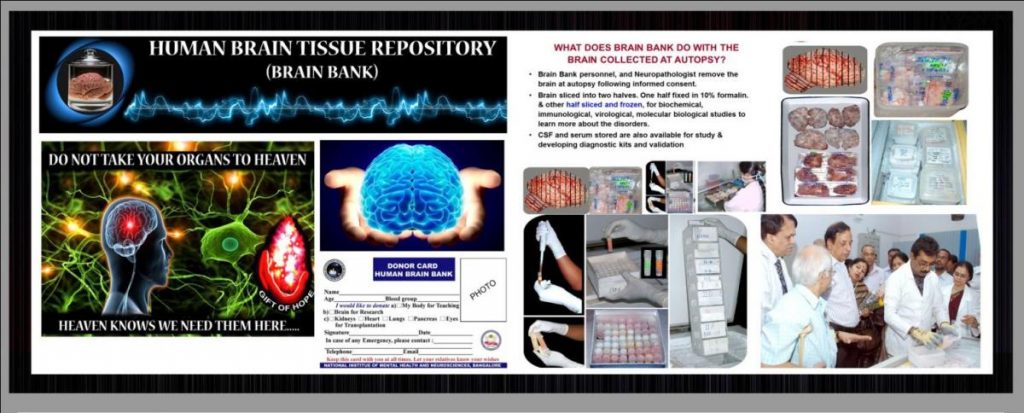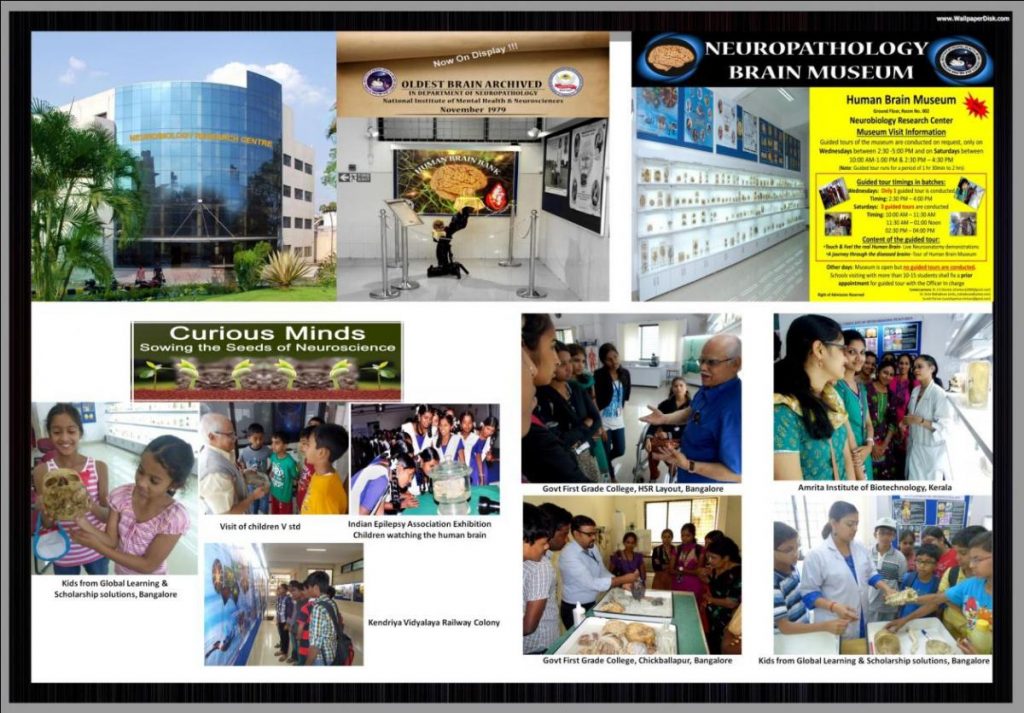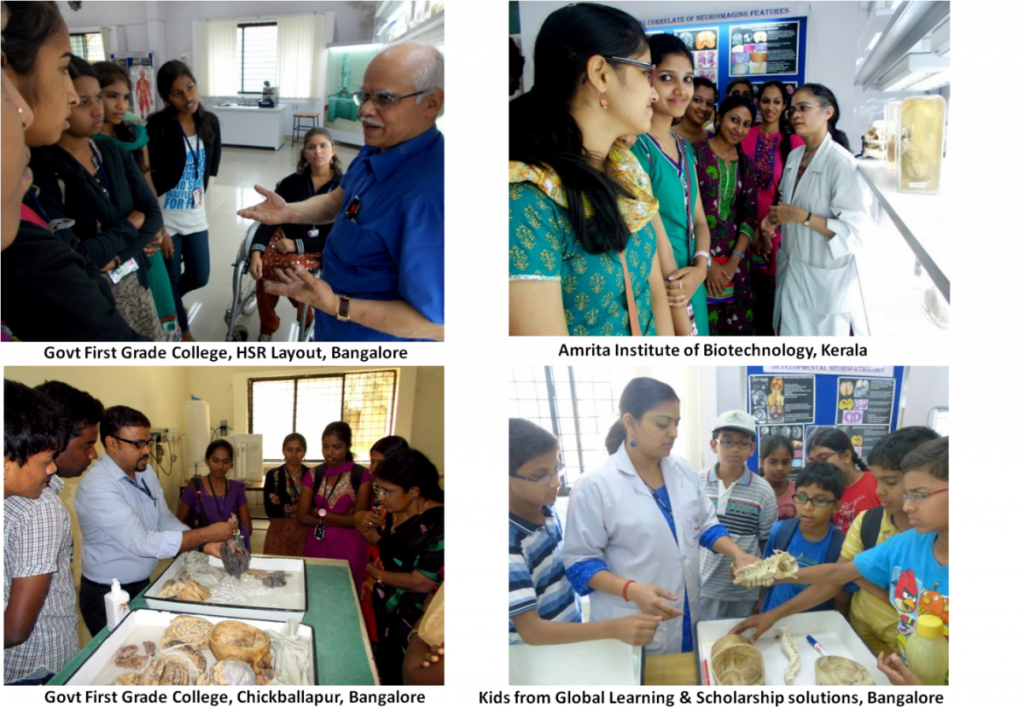Research
Central Facilities
- Human Brain Tissue repository (Human Brain Bank) (In-charge: Dr. S.K. Shankar)
The Brain Bank located in the ground floor of Neurobiology Research Centre, has continued the mandated activities of (a) collection of donated brains from cases of Neurodegenerative and Infective conditions (b) collection of brains from victims of Road Traffic Accidents, as relatively normal controls (c) Distribution of the brain tissue, CSF and serum for investigative studies. These brain specimens were collected following written informed consent from close relatives. During the year 2013-2014, brains were collected from cases of schizophrenia, stroke, brain mass lesion, HIV and TBM – two cases each. In addition 32 fresh brain biopsy samples following epilepsy surgery were collected and stored only after taking the tissue for diagnostic work. These samples were stored at -86oC. Forty four cadaver hearts from victims of road traffic accidents were collected and provided for homograft transplantation to Jayadeva Institute of Cardiology and Research Centre, Manipal Hospital and Narayana Hrudayalaya. Required brain tissues from various anatomical areas, CSF samples from normal controls and diseased states were distributed to 15 scientists for their research work throughout India. In collaboration with Institute of Bioinformatics, proteomics studies were continued in cases of tuberculous meningitis, cryptococcal meningitis, toxoplasma encephalitis, cerebral malaria, rabies encephalitis and schizophrenia. In these studies some seminal observations were reported.
Brain Bank is actively involved in promotion of neuroscience and public awareness programmes about cadaver organ donation and brain donation. Limited number of teaching slides of neuroinfections has been provided to various institutions across the country for teaching purposes. The staff of HBTR participated in the annual conference of Indian Epilepsy Association, Bangalore Chapter as volunteers. During the exhibition, 950 school children, 100 teachers from 9 schools visited the exhibition. The co-ordinator of the Brain Bank has been conducting classes in Neuroanatomy and Neuropathology as a part of Ph.D Neuroscience module and to the DM/MCh/MD Pathology students posted in Department of Neuropathology. As a public awareness event, Organ Donation Day with the distribution of green ribbon was conducted on 6th August 2013 by Mr.Suresh Parmar (Sr.Research Fellow, HBTR) and Mr.Raveendra, NRC Receptionist. Sixty seven research scholars and trainees working in various section of NRC and some administrative staff pledged their organs/brain by signing the consent form and donor card. Many more are coming forward. Healthy Heart Association of Bangalore felicitated Dr.S.K.Shankar and Dr.Anita Mahadevan for their contribution in popularizing the organ donation, Brain Banking and promotion of neuroscience in schools and colleges. Seven research articles have been published during the year utilizing the material from the Brain Bank, the Principal Co-ordinator and Associate Co-ordinator as co-authors.

- Neuropathology Brain Museum (Dept. of Neuropathology; Head: Dr Yasha TC, Officer In charge-Prof SK Shankar)
The Neuropathology Brain Museum (Human Brain Museum), only one of its kind in India is located in the ground floor, (Room 002) of Neurobiology Research Centre. This unique facility has become a centre of attraction for the students of various colleges and schools as a valuable source of Neuroscience material. In addition, this has become a tourist attraction for people to visit and see human brain in reality. During the year students from 33 colleges visited the Brain Museum. In addition many foreign scientists and dignitaries, who came to NIMHANS for scientific collaboration, have visited the Neuropathology Brain Museum and greatly appreciated unique collection and the display. Nine reporters from press and media visited and reported about the Brain Museum in their magazines. The total number of visitors to the Neuropathology Brain Museum was 2803. This number is gradually increasing with the awareness about the facility in the press and electronic and social media. In addition, human brain and spinal cord and other parenchymal organs are displayed permitting the visitors to touch and feel these organs, a unique experience enjoyed by everyone. The Department is actively involved in maintenance of the museum. The staff of Human Brain Bank regularly conducts guided tour to the visitors explaining the nature and importance of specimens exhibited. A graphic representation of the number of visitors during each month is given. Visitors to Neuropathology museum : 2803(950 school children, 100 teachers from 9 schools)


- Central facility for Millipore Water Purification system, Liquid nitrogen and Waste Disposal
There is a new high capacity Millipore (ELIX 70 Ltr/Hr and Synergy) water purification system, located in the ground floor that provides purified water used for multiple laboratory and hospital applications including ultrapure water required for molecular biology research.
The NBRC is also provided with a dedicated central waste disposal facility in the ground floor which is equipped with a large volume autoclave and a shredder for hospital / lab waste disposal.
During the year 2013-2014, the NBRC acquired a liquid nitrogen storage tank of capacity 900 litres . This is a source of supply for liquid nitrogen which is being used regularly by several laboratories at NBRC. This facility is also being used routinely by some laboratories in the administrative block such as Departments of Neurovirology, Neuropathology, Neurochemistry, Neurophysiology and Biophysiscs.
- Centre for Advanced Research for Innovation in Mental Health and Neurosciences – Funded by Department of Health Research (DHR), Ministry of Health and Family Welfare, Govt of India and Indian Council of Medical Research( ICMR-2014)
The ICMR centre for Advanced Research at NIMHANS was conceptualized during the visit of Hon’ble Minister of Health and Family Welfare, Govt of India to NIMHANS in January 2011. Realizing the leadership potential shown and the rapid progress made by NIMHANS in the field of Mental Health and Neurosciences, Department of Health Research (DHR and ICMR) decided to establish a centre for Advanced Research for Innovation of Mental Health and Neurosciences with a dual component of manpower development to achieve a critical mass of technical person and to propel translational research to take scientific investigation to the bed side medicine. The vision of the Centre for Advanced Research for Innovation of Mental Health and Neurosciences supported by DHR and ICMR at NIMHANS is “to be a leader in the field of mental health and neuroscience and evolve the state of the art and technology and innovation for translational research and develop critical mass of manpower to meet national needs by scientific collaboration and co-operation”.
The centre was inaugurated on 26th March 2014 by Dr.V.M.Katoch, Director General of Indian Council of Medical Research, New Delhi. The Advanced Centre is proposed to be located in the third floor of Neurobiology Research Centre presently the centre has three projects sanctioned after evaluation by the expert committee. The funds for the project need to be released from ICMR in near future.
Anticipating the release of funds, the Human Brain Bank has developed “an atlas of common infections of nervous system with a set of teaching slides and a booklet and this has been released by Dr.V.M.Katoch on the occasion.
The following projects and a manpower training initiative in this center:
- Project 1: Development of Neuroscience Educational Material for popularizing Neuroscience under Human Brain Bank, Department of Neuropathology, NIMHANS
- Project 2: Translational Research in Amyotrophic Lateral Sclerosis (ALS) – Development of Biomarkers for diagnosis, monitoring disease progression and evaluation of toxicity, Department of Neurophysiology, NIMHANS
- Project 3: Development of ELISA and evaluation of the potential of 14-3-3 protein as a biomarker of neural injury / Neurodegeneration with special reference to Creutzfeldt –Jakob disease, Department of Neurochemistry, NIMHANS
- PDF: Post Doctoral Fellowship in Neurocritical Care

